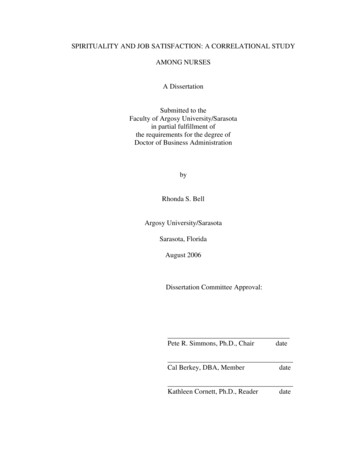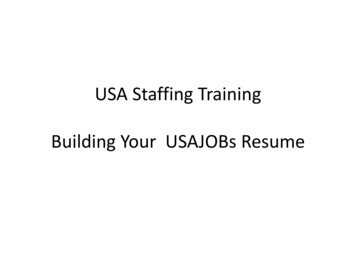
Transcription
05/25/2022IN THE SUPREME COURT OF THE STATE OF MONTANACase Number: OP 22-0139OP 22-0139RHONDA LINDQUIST and OFFICE OF STATE PUBLIC DEFENDERPetitioners,v.MONTANA THIRTEENTH JUDICIAL DISTRICT COURT, HON. DONALDHARRISRespondents.BRIEF OF AMICI CURIAE THE ACLU OF MONTANAFOUNDATION AND THE AMERICAN CIVIL LIBERTIES UNIONFOUNDATIONOn Appeal from the Montana Thirteenth Judicial District Court,Yellowstone County, Cause N. SB-2021-1,The Honorable Donald L. Harris Presiding.APPEARANCES:Akilah LaneAlex RateACLU of Montana Foundation, Inc.P.O. Box 1968Missoula, MT 59806(406) Emma Andersson *American Civil Liberties Union125 Broad StreetNew York, NY 10004(347) 931-6337eandersson@aclu.orgAttorneys for Amici ACLU of MontanaFoundation and ACLU Foundation*Pro hac vice
Peter F. HabeinCROWLEY FLECK PLLPP.O. Box 2529Billings, MT 59103(406) 252-3441phabein@crowleyfleck.comAttorney for Petitioner RhondaLindquist and Office of State PublicDefenderEmily Jones,Special Ass’t Attorney General115 N. Broadway, Suite 410Billings, MT 59101(406) 384-7990emily@joneslawmt.comAttorney for State of MontanaAustin Knudsen,Montana Attorney GeneralDavid M.S. Dewhirst,Solicitor GeneralMorgan J. Varty,Ass’t Attorney General215 North SandersP.O. Box 201401Helena, MT 59620(406) torneys for State of MontanaTimothy B. Strauch257 W. Front Street, Ste. AMissoula, MT 59802(406) 532-2600tstrauch@strauchlawfirm.comAttorney for Respondent 13th J.D.Court, Hon. Donald HarrisL. Randall BishopL. Randall Bishop, AAL27 Prairie Falcon Ct.Kalispell, MT 59901(406) 670-9394rbishop@lrblawyers.comAttorney for Amicus Curiae MontanaInnocence ProjectMarty LambertGallatin County Attorney1709 W. CollegeBozeman, MT 59715marty.lambert@gallatin.mt.govAttorney for Amicus Curiae MontanaCounty Attorneys AssociationNikki Trautman BaszynksiPro hac vice215 East 9th Street, Suite 601Cincinnati, OH 45202(614) 362-1644 x95nbaszynski@ohiojpc.orgAttorney for Amicus Curiae NationalAssociation of Public DefenseJordan KilbyP.O. Box 16960Missoula, MT 59808(406) 541-4100jordan@westernmontanalaw.comAttorney for Amicus Curiae NationalAssociation of Public Defense
TABLE OF CONTENTSTABLE OF AUTHORITIES . iiINTEREST OF AMICI CURIAE .1INTRODUCTION .1ARGUMENT .2I. Montana Has Long Resisted and Neglected its Obligation to Ensure thatthe Right to Counsel Exists for Everyone .2A. The ACLU Had to Sue Montana for it to Establish the Office ofStatewide Public Defender .2B. Montana’s Political Branches Undermined the Potential of thePublic Defender Act by Failing to Adequately Fund the System .4C. An Ever-Expanding Criminal Legal System Compounds theProblem of Insufficient Funding for Public Defense .8II. This Court Can and Should Exercise its Authority to Protect the Right toCounsel in Montana .9A. Only Systemic Solutions Can Remedy Systemic ConstitutionalFailuresated. .9B. The Right to Counsel Requires States to Spend Money toAdequately Fund Indigent Defense .12C. This Court’s Precedent Establishes that it May Review LegislativeFunding Decisions and Determine Whether Funding Systems areConstitutionally Adequate .16D. This Court Can Immediately Mitigate the Crisis and ProtectMontanans’ Right to Counsel .20CONCLUSION .22CERTIFICATE OF COMPLIANCE .23CERTIFICATE OF SERVICE .24i
TABLE OF AUTHORITIESCasesButte-Silver Bow Loc. Gov't v. Olsen, 228 Mont. 77, 743 P.2d 564 (1987).19Carrasquillo v. Hampden Cnty. Dist. Cts., 142 N.E.3d 28 (2020) . 1, 11, 20Coate v. Omholt (1983), 203 Mont. 488, 662 P.2d 591 .20Columbia Falls Elementary Sch. Dist. No. 6 v. State, 2005 MT 69, 326 Mont. 304,109 P.3d 257 . 16, 17, 18, 19Gallatin Cnty. v. Montana Eighteenth Jud. Dist. Ct., 281 Mont. 33, 930 P.2d 680(1997) .19Gideon v. Wainwright, 372 U.S. 335 (1963) . 12, 13, 14Hurrell-Harring v. State, 930 N.E.2d 217 (N.Y. 2010) . 11, 14, 15Kuren v. Luzerne Cnty, 146 A.3d 715 (2016). 11, 12Kuren v. Luzerne Cnty, 637 Pa. 33 (2016).14Lavallee v. Justices in the Hampden Superior Court, 442 Mass. 228 (2004) .20Marbury v. Madison, 5 U.S. 137 (1803) .15N.Y. Cnty Lawyers’ Ass’n v. State, 196 Misc. 2d 761 (N.Y. Sup. Ct. 2003) .15Office of State Public Defender’s Petition for Writ of Certiorari, Cause No. OP 22139, OPDApp.7Simmons v. State Pub. Defender, 791 N.W.2d 69 (Iowa 2010) .14State v. Schneider, 2008 MT 408, 347 Mont. 215, 197 P.3d 1020.13State v. Young, 143 N.M. 1 (2007) .14Stroebe v. State, 2006 MT 19, 331 Mont. 23, 127 P.3d 1051 .19Tucker v. State, 168 Idaho 570 (Idaho 2021).11Tucker v. State, 394 P.3d 54 (Idaho 2017). 10, 12White v. Martz, Cause No. DV-2002-133 (Montana First Judicial District, Lewisand Clark County, 2002).3, 4White v. Martz, Cause No. DV-2002-133 (Montana First Judicial District, Lewisand Clark County, 2006).4Wilbur v. City of Mount Vernon, 989 F. Supp. 2d 1122 (W.D. Wash. 2013) . 11, 12,15Wilbur v. City of Mount Vernon, No. 2:11-CV-1100, 2012 WL 600727 (W.D.Wash. Feb. 23, 2012) .11Statutes§ 20-9-309, MCA .19ii
§ 45-10-103, MCA .21§ 45-10-104, MCA .21§ 45-10-106, MCA .21§ 45-7-301, MCA .21§ 45-8-101, MCA .21§ 45-8-113, MCA .21§ 45-8-114, MCA .21§ 45-8-115, MCA .21§ 45-8-116 MCA .21§ 45-8-201, et seq., MCA.21§ 45-8-215, MCA .21§ 45-9-102, MCA .21§ 45-9-107, MCA .21§ 45-9-110, MCA .21§ 45-9-115, MCA .21§ 45-9-121, MCA .21§ 45-9-127, MCA .21§ 47-1-102, MCA .4§ 47-1-105(b),(c), MCA .17§ 47-1-202(c), MCA .17Other AuthoritiesABA Ten Principles of a Public Defense Delivery System, Principle 5 .17ABA Ten Principles, Principle 6 .18ABA Ten Principles, Principle 8 .18Billings Municipal Code Sec. 18-1001 et seq.21Billings Municipal Code Sec. 18-1104(a) .21Billings Municipal Code Sec. 18-1110 .21Billings Municipal Code Sec. 18-1204 .21Billings Municipal Code Sec. 18601-18605 .21Billings Municipal Code Sec. 18-701 .21Billings Municipal Code Sec. 18-702 .21Billings Municipal Code Sec. 18-906 .21Billings Municipal Code Sec. 22-101 .21Billings Municipal Code Sec. 22-102 .21Billings Municipal Code Sec. 24-1002 .21Billings Municipal Code Sec. 27-1704 .21iii
Billings Municipal Code Sec. 3-202 .21Billings Municipal Code Sec. 3-304(a)-(e).21Guide to Judiciary Policy, Vol. 7: Defender Services § 230.16(A) (May 2019),available at a-ch02.pdf /# (citing Bureau of JusticeStatistics (BJS), Corrections Statistical Analysis se-new-assignments-in-pay-dispute/article b0982e9b-7f6c-50c2abf6-6efe1cfcbf8a.html .7https://publicdefender.mt.gov/ Annual-Report.pdf .5, istrative/legal aid indigent defendants/ls sclaid pub def 2019 fall / lic-defenders-attorneys-say l-advisory-commission/blackletter .5National Center for Defense Management, a project of the National Legal Aid &Defender Association; Montana Statewide Defender Systems Development Study,1976, p. 15.2Paul Butler, Poor People Lose: Gideon and the Critique of Rights, 122 Yale .13Performance Audit; Public Defender Workforce Management, Office of the StatePublic Defender, September 2020, p. 21. .6Senate Bill 145, the Montana Public Defender Act .4U.S. Amicus Brief, https://www.justice.gov/opa/file/769806/download .12U.S. t/legacy/2013/08/15/wilbursoi8-1413.pdf .12Welcome to Yellowstone County, MT - Detention Center Search Listing(yellowstonecountymt.gov) .21RulesMont. R. Prof’l. Conduct. 1.3 .9iv
Constitutional ProvisionsMont. Const. art II, § 24 .12Mont. Const. art VII § 2(3) .20Mont. Const. art. X, § 1(3) .16v
STATEMENT OF INTEREST OF AMICI CURIAEThe American Civil Liberties Union Foundation (“ACLU”) and the stateaffiliate, American Civil Liberties Union Foundation of Montana (“ACLU-MT”),are non-partisan organizations committed to supporting and protecting civilliberties. Amici have a long, extensive history of advocating for effectiverepresentation of criminal defendants, ensuring that public defense systemseffectively implement the right to counsel, and supporting those whoseconstitutional rights have been violated within the criminal justice system.INTRODUCTION“[B]y promoting the integrity and accuracy of the government’s lawenforcement operations, a robust public defender system not only protects therights of indigent defendants, but also helps to increase public safety, to avoid thecosts of wrongful convictions, and to protect the constitutional rights of all of[Montana’s] residents. And where the public defender system fails to fulfill itsmission due to inadequate funding, that failure not only undermines theconstitutional rights of indigent defendants, but indirectly injures us all.”Carrasquillo v. Hampden Cnty. Dist. Cts., 142 N.E.3d 28, 54 (2020).1
ARGUMENTI.Montana Has Long Resisted and Neglected its Obligation to Ensurethat the Right to Counsel Exists for Everyone.The current controversy arising out of Yellowstone County is emblematic ofMontana’s halfhearted commitment to upholding the constitutional right to counseland reflects the longstanding fragility of our public defense system. Thiscontroversy is neither unique nor isolated. Amici urge the Court to consider thiscase within the larger context of Montana’s checkered history of public defense.A. The ACLU Had to Sue Montana for it to Establish the Office ofStatewide Public DefenderTwentieth century public defense in Montana was a hodge-podge of countyadministered programs utterly lacking in uniform quality, standards, oraccountability. The counties designed and administered their own public defenseprograms and were reimbursed by the state for services rendered. The state,however, failed to set standards for the provision of services, failed to exercise anysupervision to ensure that the counties’ programs met constitutional standards, andfailed to adequately fund the county programs. As far back as 1976, the NationalCenter for Defense Management identified numerous deficiencies with Montana’scounty-based system. 1 In 1981, in an overwhelmingly bipartisan vote, the MontanaNational Center for Defense Management, a project of the National Legal Aid & DefenderAssociation; Montana Statewide Defender Systems Development Study, 1976, p. 15.21
Legislature passed a joint resolution finding that “the constitutional requirement ofthe effective assistance of counsel for persons accused of crimes had not beenachieved consistently on a statewide basis.” 2 Despite this knowledge, theLegislature failed to take any significant remedial action and, in the meantime, theproblem only got worse.On February 14, 2002, the ACLU filed suit against the State of Montana andseven of its counties alleging a failure to adequately fund and supervise countypublic defense programs. White v. Martz, Cause No. DV-2002-133 (Montana FirstJudicial District, Lewis and Clark County, 2002). The lawsuit alleged that the statehad abdicated its constitutional duty to ensure effective counsel for the poor bydelegating the design and administration of those programs to its counties, withoutsufficient funding or guidance. Due to the lack of state oversight, county programswere plagued by a number of deficiencies, including: a virtual absence ofadversarial advocacy; high attorney caseloads; the inability of lawyers tomeaningfully confer with their clients or to develop a defense; lack of investigatoryand expert services; excessive plea bargaining and unnecessary pre-trialincarceration.Ultimately, the parties entered into a settlement, agreeing that “a properlyfunded state-wide public defender system with sufficient administrative senate/joint/SJR02.pdf3
financial resources is necessary to ensure that indigent criminal defendants receiveconstitutionally and statutorily adequate legal representation.” Stipulation andOrder of Postponement of Trial, White v. Martz, Cause No. C DV-2002-133(Montana First Judicial District, Lewis and Clark County, 2004).In 2005, as a result of the settlement agreement, the Montana Legislaturepassed Senate Bill 145, the Montana Public Defender Act (“the Act”), and ourmodern system of public defense was born. The Act established a statewide publicdefender system staffed by “qualified and competent counsel” and supported by“adequate public funding.” § 47-1-102, MCA. While the Act represented anenormous step towards Montana fulfilling its constitutional duty, in many respectsits promises remain unmet.B. Montana’s Political Branches Undermined the Potential of thePublic Defender Act by Failing to Adequately Fund theSystem.Despite the settlement in White and passage of the Act, the White plaintiffsremained concerned that insufficient funding would thwart implementation of thenew system. Memorandum and Order on Motions to Dismiss, White v. Martz,Cause No. C DV-2002-133 (Montana First Judicial District, Lewis and ClarkCounty, 2006). Those concerns were prescient. The Office of the State PublicDefender (hereinafter “OPD” or “agency”) is a vast improvement over Montana’s4
old county-by-county approach, but it has been plagued by chronic underfundingsince its beginning.Nearly every biennium, OPD has had to seek “supplemental” fundingfrom the Legislature outside of the typical appropriations process. 3Supplemental funding is a legislative mechanism by which an agency thathas overspent its budget can ask for additional funding to complete the fiscalyear. This long-simmering crisis culminated in 2015, when the Legislaturestripped away the agency’s entire base budget in favor of one-time funding.As a result, in 2016 OPD projected a deficit of between 2.5 and 3.5million for fiscal year 2017.4 This deficit forced the agency to implement adraconian cost saving plan involving hiring freezes and rate reductions forcontract attorneys. 5Today, Montana’s public defenders routinely represent more defendants thanthe maximum caseloads recommended by the National Advisory Commission onCriminal Justice Standards and Goals,6 which is the only national caseloadstandard for public defense that currently exists. In fiscal year 2019, for example,https://publicdefender.mt.gov/ ; ission/black-letter53
eight out of the fourteen OPD regions reported staff exceeding recommendedcaseloads.7 Excessive caseloads are an insurmountable problem for publicdefenders, no matter how skilled or hardworking individual attorneys may be. Asone expert has explained, “[w]hen caseloads are excessive, indigent defendants areat serious risk of harm. The predicament is much like a cardiologist who mustcomplete 10 surgeries every day. At first the cardiologist will try to take thenecessary time with each patient, extending the day to try to perform at a top leveldespite incredible time constraints. But eventually she will have no choice but tocut corners. The care of certain patients will be sacrificed to create more time forothers.”8OPD has reported that there is an “increased backlog of open and activecases leading to longer assignment times in parts of the State.” 9 The pandemichas only exacerbated the situation, “as it has both expanded the number ofindividuals eligible for OPD representation while simultaneously increasingpressure on the Agency’s ability to recruit and retain both [full-time employees]and contractors.”10 Recruitment and retention is a persistent and worseningPerformance Audit; Public Defender Workforce Management, Office of the State PublicDefender, September 2020, p. ministrative/legal aid indigent defendants/lssclaid pub def 2019 fall caseloads.pdf9https://publicdefender.mt.gov/ -AnnualReport.pdf10Id.67
problem for OPD, as public defenders are paid many thousands of dollars less thanother state attorneys in comparable roles. Office of State Public Defender’sPetition for Writ of Certiorari, Cause No. OP 22-139, OPDApp.192-194.On top of the challenges OPD faces representing its own clients, it hasbecome increasingly difficult for OPD to find contract attorneys willing to takecases when OPD is conflicted out. Compensation rates for contract publicdefenders have stagnated in the last decade and failed to keep pace with risingcosts of living. Id., OPDApp.194-195. Recently, a group of private contractattorneys refused to take additional conflict cases from OPD because the state waspaying them lower rates ( 56/hour) than it pays attorneys in other counties.11 Thiscontract attorney rate has actually decreased from 62/hour. OPDApp. 194-195.Even in those counties with the highest hourly rate for contract attorneys, payremains well below the market rate. For example, the rate paid to federal baradvocates under the Criminal Justice Act was 90 in 2005 and incrementallyincreased every 1 to 3 years to its current rate of 148.12 This disparitydisincentivizes attorneys from representing indigent clients in state court.Id; -assignments-in-pay-dispute/article b0982e9b-7f6c-50c2-abf6-6efe1cfcbf8a.html12See Guide to Judiciary Policy, Vol. 7: Defender Services § 230.16(A) (May 2019), available 07a-ch02.pdf, add. 79-84.711
Thus, since OPD’s inception, the Legislature has persistentlyundermined its own creation: Montana’s public defense system cannotachieve its promise without appropriate funding.C. An Ever-Expanding Criminal Legal System Compounds theProblem of Insufficient Funding for Public DefenseBetween 1980 and 2016, Montana’s prison population increased by 416percent. 13 As of 2019, there were 2,706 people in Montana state prisons, and in2015 more than 2,000 additional people were held in county jails across the state.14In 2015, nearly one in five people entering Montana’s prisons were admitted for adrug offense, 67 percent of which were possession offenses. 15 Between 2008 and2018, admissions to the state’s prisons increased by 24 percent, while releasesfrom prison increased by only 18 percent.16 The national average rate of stateimprisonment dropped by 7 percent between 2000 and 2016, while Montana’s rateof imprisonment increased by 6 percent.17Hundreds of people—462 people in 2017—are incarcerated each year inMontana for technical or compliance violations of probation or parole. 18 Many a/# (citing Bureau of Justice Statistics (BJS),Corrections Statistical Analysis Tool.14Id.15Id.16Id.17Id.18ACLU of Montana, Set Up to Fail: Montana’s Probation & Parole iles/field .pdf, p. 6.813
caught in the system as a result of an inability to pay fees and costs associated withbail and pretrial release programs, rather than any deliberate noncompliance withcourt orders. Put plainly, these individuals are incarcerated because they are poor.The current crisis in Yellowstone County is therefore unsurprising. Thesystem has buckled under pressure from years of underfunding and understaffing,coupled with a steady increase in the need for public defense, and a Legislatureuninterested in zealously protecting the right to counsel. The court belowunderstood that OPD is unable to immediately assign public defenders because ofbudget and funding issues, extremely high caseloads, and difficulty attracting andretaining attorneys. The crisis in Yellowstone is not an outlier: it is the latest andmost public manifestation of a statewide system in long-term crisis.II.This Court Can and Should Exercise its Authority to Protect theRight to Counsel in MontanaA. Only Systemic Solutions Can Remedy Systemic Constitutional FailuresThis matter is before the Court because Montana’s political branches ofgovernment have failed to ensure that all Montanans’ right to counsel is protected.The parties are both in an impossible situation. OPD may not take more cases thanits office can competently handle. If it does, it will create an ethical conflict: inorder for one client to be effectively represented, another client’s case must beneglected. See, Mont. R. Prof’l. Conduct. 1.3. Meanwhile, Judge Harris is trying toprevent indigent criminal defendants from going unrepresented and facing a grave9
violation of their constitutional rights. This is not a crisis of the parties’ making,and neither party has the power to address the underlying causes of systemicdeficiencies throughout Montana. But this Court does have the power to ensure theright to counsel in Montana is a reality. This Court can order meaningful systemicremedies: it should seize this opportunity to protect the rights of Montanans andthe integrity of the state’s criminal legal system.In jurisdictions across the country, courts have concluded that when publicdefense systems are failing, it is proper to order prospective systemic relief. Thesecourts recognize that systemic constitutional crises cannot be resolved throughretroactive case-by-case adjudication. And the United States Department of Justice(“DOJ”) agrees. Faced with a longstanding systemic failure, this Court, too, shouldorder relief commensurate with the widespread scope of the problem.The Supreme Court of Idaho has twice acknowledged that systemic failuresin public defense justify systemic remedies. In Tucker v. State, the court concludedthat a putative class of indigent criminal defendants could challenge deficiencies inthe public defense system and seek systemic, rather than individual, relief. 394P.3d 54, 62-63 (Idaho 2017). Several years later, the court reaffirmed thisconclusion. It held that systemic relief is available where systemic failures areproven by a preponderance of the evidence and that “structural evidence, such asstatistics and national standards can [] be probative of the existence of systemic10
denials of counsel and may suffice.” Tucker v. State, 168 Idaho 570, 585 (Idaho2021). Similarly, the highest court in New York concluded that prospectiveinjunctive relief is available to remedy systemic violations of the right to counsel.Hurrell-Harring v. State, 930 N.E.2d 217 (N.Y. 2010). The Pennsylvania SupremeCourt has also “recognized the viability of a cause of action for prospectiveinjunctive relief” for a failing public defense system. Kuren v. Luzerne Cnty, 146A.3d 715, 749 (2016). See also Carrasquillo, 142 N.E.3d 28, 36 (faced with acrisis in a single county, the Massachusetts Supreme Judicial Court “outlin[ed] aprocess through which” the public defender in any county throughout the state“
Missoula, MT 59808 (406) 541-4100 . jordan@westernmontanalaw.com Attorney for Amicus Curiae National Association of Public Defense 257 W. Front Street, Ste. A . Missoula, MT 59802 (406) 532-2600 . tstrauch@strauchlawfirm.com . Attorney for Respondent 13th J.D. Court, Hon. Donald Harris . L. Randall Bishop . L. Randall Bishop, AAL . 27 Prairie .










